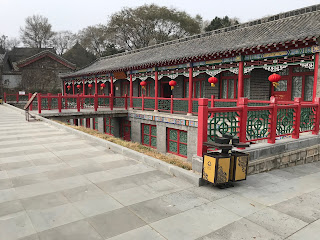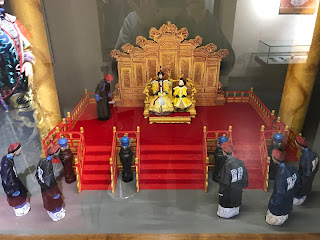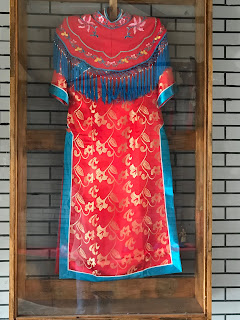This was going to be included in part 4 originally, but I thought that with the amount of pictures I wanted to include, that a separate post would be in order. So it was Sunday, our third whole day in Siping. Yifu picked us up at the apartment, and then we drove to another part of town to pick up Lifu as well. The five of us, in a corolla sized car headed south east out of town. I was not aware of where we were going as yet. Our first stop was in a small village where Zhuoyue bought some flowers. I am still wondering what was going on when we stopped on the highway next to the Shanmen Reservoir. We walked across the highway, and took a path up the hill. Walking along the path I notice flowers and markers, This was a burial area! We were going to pay our respects to Qiuyan, Yifu, and Lifu's mother. I knew the mom I met was not her birth mother, but, the Chinese don't use all that step bit, she is just mom. I was surprised at the informality of the burial area. Their mother was in an area surrounded by a stone wall, the diameter of which was probably 30 feet or so, with a burial mound in the center surrounded by a stone retaining wall, but, no marker. I thought it quite interesting but I didnt' ask any questions. I may do that someday though. Just to figure out why it is setup so. After they hung out a bit and put the flowers in the ground we clambered down to the car and were off again.
At some point I was informed by Zhuoyue that we were off to see the house of the Empress Cixi. This, as it would turn out would be the ancient city of YeheNara. When we first were driving up to the area we came upon a hill with a granite sign, which unbeknownst to me was the site of the ancient city of YeheNara West. We turn around, and after skirting the Zhuanshanhu Reservoir on dirt roads we came to the city of YeheNara East. Now YeheNara East (link is to Trip.com for more info) is a recontruction done in 1994. It looks pretty authentic and follows the construction of the Qing period you can see all over Beijing. This being the off season, and really almost time for it to close up for the year, the place was practically deserted. I could tell by the signage and empty carts in some of the squares that they have all kinds of entertainment, and vendors during the peak season. I imagine it's really cool to see all that.
 |
| Coming up to the main gate from the parking area |
 |
| Inside the Main Gate |
 |
| First Museum Building |
 |
| First Courtyard |
We came up to this first building and before I went inside I noticed this sign
I found this interesting, not because of the English, but because of the Manchu writing. You see, the city of YeheNara was home to the Manchu Nara clan. The YeheNara branch was very important branch, and could claim three Qing empresses, as well as many other mistresses and consorts. The notable names here are Empress Xiaocigao, upgraded from consort to empress posthumously, Empress Xiaoqinxian (better known in the west as Empress Dowager Cixi), and Empress Xiaodingjing (also known as Empress Dowager Longyu). Longyu was the last Empress, reigning from 1908 to the end of Imperial China in 1912, while the "Last Emperor" Puyi was still a child. Click here for more information on the Nara Clan.
There is a ton of stuff to see here. Inside the first building there was a diorama of the ancient city.
That definitely got my juices flowing and I wanted to see more. There was plenty of displays and other dioramas to see.
And that was just the first building. After that building, and before we explored the rest, some impromptu berry picking took place.
I did not partake in eating, but Qiuyan and Lifu chowed down. I did help pull branches lower since I am tall and they are not.
There was building upon building of displays
 |
| Cixi, the power behind the throne |
 |
| And then there was no longer any need for pretenses about where the power lie |
Sadly, for me anyway, outside of a few exterior signs (as shown above) nothing was in English. Everything is so cool though that I loved my time there.
The grounds look to be beautiful during the spring though they were pretty decent even well into fall.
 |
| Overlooking the Zhuanshanhu Reservoir |
 |
| Me grabbing a selfie with one of the city guards |
And just when you think you had seen it all there was more!
Lots of examples of Qing era clothing and armor. The lighting was atrocious, and glared on the glass quite a bit.They even had a screen you could stand in front of to take a picture of yourself wearing period clothing. Sadly the men's clothing wasn't working, and it would not send the pictures via wechat as it was supposed to, so, you get this screen shot of me in a Qing era dress.
As you can see, it is quite lovely on me. If not quite the right size.
As we were leaving we noticed a gate on the other side of the parking area.
Behind it was a large area where you would typically see dozens of people practicing Kung Fu.
It is actually a martial arts school there, though it was closed. But, in the spirit of the place Lifu gave me a few martial arts poses in front of the gate.
Like I said, he is a fun loving guy! I have discovered a few facts since my return. YeheNara west does have some stone markers and some stone remains of the city, but very little, and nothing there to explain other than in Mandarin. If you go to the link I provided for YeheNara east, there are some reviews/comments that show a few pics of YeheNara west.
Oddly enough YeheNara is considered to be part of Siping, even though it is about 25 clicks away, though it is not a part of Siping City. There must be some sort of governmental division there, but I don't know what it is. I have also learned that the Manchu are a Jurchen people. Pretty interesting stuff. I just got through the Tang on my reading of Imperial China, so I really look forward to this part coming up later this year. So that was all we did there. We headed back to Siping, stopping at a roadside restaurant for a nice meal, then back home. That is all for Part 5. Part six will reveal the cool stuff hidden in the city of Siping itself.















































Bring on part 6!
ReplyDelete